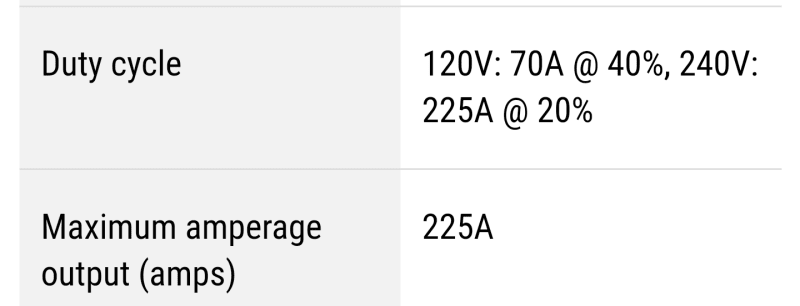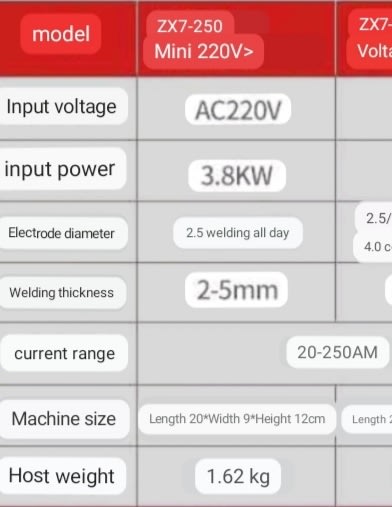Navigation
Install the app
How to install the app on iOS
Follow along with the video below to see how to install our site as a web app on your home screen.
Note: This feature may not be available in some browsers.
More options
Style variation
-
Congratulations TugboatEng on being selected by the Eng-Tips community for having the most helpful posts in the forums last week. Way to Go!
You are using an out of date browser. It may not display this or other websites correctly.
You should upgrade or use an alternative browser.
You should upgrade or use an alternative browser.
using 250 ampere welding machine for medium scale carbon arc furnace power supply? 3
- Thread starter Uralsk
- Start date
- Status
- Not open for further replies.
TugboatEng
Marine/Ocean
Two things:
1. That 60% duty cycle means it can operate for 6 minutes every 10 minutes.
2. You did not tell us what amperage setting that duty cycle is for. I would guess it's around 100 amps. At 250 amps you'd be lucky to get 1-2 minutes of run time in 10.
To answer your question, no this power supply has nowhere near the capacity you need to melt 20kg of metal.
1. That 60% duty cycle means it can operate for 6 minutes every 10 minutes.
2. You did not tell us what amperage setting that duty cycle is for. I would guess it's around 100 amps. At 250 amps you'd be lucky to get 1-2 minutes of run time in 10.
To answer your question, no this power supply has nowhere near the capacity you need to melt 20kg of metal.
- Moderator
- #3
When I see a welding machine rated at 250 Amps and 60% duty cycle I assume that the duty cycle is at full output.
60% of 250 Amps is 150 Amps.
The heat generated internally is related to the output current.
I would not run the machine at over 150 Amps without cool-down intervals.
But what are the specs of your furnace?
If the furnace demands more than 150 Amps or more than the welding voltage (Not the open circuit voltage) it won't work well.
Try it. It's a cheap welder.
--------------------
Ohm's law
Not just a good idea;
It's the LAW!
60% of 250 Amps is 150 Amps.
The heat generated internally is related to the output current.
I would not run the machine at over 150 Amps without cool-down intervals.
But what are the specs of your furnace?
If the furnace demands more than 150 Amps or more than the welding voltage (Not the open circuit voltage) it won't work well.
Try it. It's a cheap welder.
--------------------
Ohm's law
Not just a good idea;
It's the LAW!
- Thread starter
- #4
-
3
- #5
Let's be unrealistic and make TWO assumptions.
1) Assume the welder is an ideal machine (no losses). Therefore, power in = power out.
2) Assume the piece to be melted starts out at room temperature (20 C).
From the nameplate, power IN = power OUT = 3800 Watt = 3800 Joules/second.
Specific heat of Aluminum is 0.9 kJ/kg.C
Melting point of Aluminum is 660 C.
Latent heat of fusion (for Aluminum) is 390 kJ/kg.
The mass of the piece in question is 20 kg.
Energy to get to melting point = (mass) x (specific heat) x (temp differential) = (20 kg)*(0.9 kJ/kg.C)*(660-20 C) = 11520 kJ.
Energy to actually melt the mass once to temperature = (mass) x (latent heat of fusion) = (20 kg)*(390 kJ/kg) = 7800 kJ.
Thus total energy required = 11520 + 7800 = 19320 kJ.
How long to melt = (total energy) / (available power) = (19320 kJ)/(3.8 kJ/s) = 5084 seconds = 84 minutes, 44 seconds.
So how much can be melted in 300 seconds?
Energy available = (3.8 kJ/s)*(300 s) = 1140 kJ.
Mass melted = (20 kg)*(1140 kJ)/(19320 kJ)= 1.18 kg.
Now figure it out for the ACTUAL machine efficiency and starting room temperature.
Converting energy to motion for more than half a century
1) Assume the welder is an ideal machine (no losses). Therefore, power in = power out.
2) Assume the piece to be melted starts out at room temperature (20 C).
From the nameplate, power IN = power OUT = 3800 Watt = 3800 Joules/second.
Specific heat of Aluminum is 0.9 kJ/kg.C
Melting point of Aluminum is 660 C.
Latent heat of fusion (for Aluminum) is 390 kJ/kg.
The mass of the piece in question is 20 kg.
Energy to get to melting point = (mass) x (specific heat) x (temp differential) = (20 kg)*(0.9 kJ/kg.C)*(660-20 C) = 11520 kJ.
Energy to actually melt the mass once to temperature = (mass) x (latent heat of fusion) = (20 kg)*(390 kJ/kg) = 7800 kJ.
Thus total energy required = 11520 + 7800 = 19320 kJ.
How long to melt = (total energy) / (available power) = (19320 kJ)/(3.8 kJ/s) = 5084 seconds = 84 minutes, 44 seconds.
So how much can be melted in 300 seconds?
Energy available = (3.8 kJ/s)*(300 s) = 1140 kJ.
Mass melted = (20 kg)*(1140 kJ)/(19320 kJ)= 1.18 kg.
Now figure it out for the ACTUAL machine efficiency and starting room temperature.
Converting energy to motion for more than half a century
There are also losses associated with the arc being on top of the load.
[ul]
[li]If the arc is above the load, between two carbons, a considerable amount of energy is lost to the furnace roof until the roof heats.[/li]
[li]If a single carbon is used, there is the same problem until the carbon arc drills into the load, This arrangement has the additional problem of needing a contact to the melt at the bottom of the furnace.[/li]
[li]In both cases there is a potential problem regulating arc voltage. Voltage is a somewhat unstable function of arc length, which in commercial furnaces is automatically regulated. Of course you can dress out and handle the carbon holder to manually adjust the arc length (i would not do that myself).[/li]
[/ul]
For an aluminum furnace it is significantly easier to heat it with natural gas or propane, than electric arc. example 750000btuh costs about $500, or you can make your own.
[ul]
[li]If the arc is above the load, between two carbons, a considerable amount of energy is lost to the furnace roof until the roof heats.[/li]
[li]If a single carbon is used, there is the same problem until the carbon arc drills into the load, This arrangement has the additional problem of needing a contact to the melt at the bottom of the furnace.[/li]
[li]In both cases there is a potential problem regulating arc voltage. Voltage is a somewhat unstable function of arc length, which in commercial furnaces is automatically regulated. Of course you can dress out and handle the carbon holder to manually adjust the arc length (i would not do that myself).[/li]
[/ul]
For an aluminum furnace it is significantly easier to heat it with natural gas or propane, than electric arc. example 750000btuh costs about $500, or you can make your own.
TugboatEng
Marine/Ocean
waross said:When I see a welding machine rated at 250 Amps and 60% duty cycle I assume that the duty cycle is at full output.
60% of 250 Amps is 150 Amps.
Welcome to the world of power tool ratings. Vacuums and air compressor power ratings are based off the locked rotor amps.
Here is a duty cycle description for a Harbor Freight welder of similar output from a much larger unit and at 6x the cost.


Another giveaway is that the welder "weld all day at 2.5mm". That would imply a 100% duty cycle st 50 amps. Then again, when stick welding one spends a fraction of the time welding vs changing electrodes and prepping for the next. In that case the 100% duty cycle is likely much closer to 25amps.
EdStainless
Materials
A I recall our 450A Millers would do 300A continuous (we ran 12 hours solid).
Look into building your own gas fired furnace.
= = = = = = = = = = = = = = = = = = = =
P.E. Metallurgy, consulting work welcomed
Look into building your own gas fired furnace.
= = = = = = = = = = = = = = = = = = = =
P.E. Metallurgy, consulting work welcomed
- Moderator
- #9
67% duty cycle?A I recall our 450A Millers would do 300A continuous
--------------------
Ohm's law
Not just a good idea;
It's the LAW!
electricuwe
Electrical
Beside the lack of power, I have never seen aluminum being melted by an arc furnace. Small induction furnace would be a reasonable choice.
15kW induction power supplies run about $1200, Not sure if the welding power supply can be adjusted to drive a induction coil. You still need a crucible and the induction coil.
there is a 1400W induction unit listing for under $400, including a crucible.
Propane furnace with crucible https://www.amazon.com/dp/B09G9MZKJB?pd_rd_i=B09G9MZKJB&pf_rd_p=6cfa532e-9c8f-48d2-87a3-a61547a0d356&pf_rd_r=7TSGP59F41XFNNA87T9T&pd_rd_wg=hSbBJ&pd_rd_w=orr2P&pd_rd_r=54cfb74f-c389-48d1-b5c0-11ec53878c53]lists for $175[/url]
Lots of options.
there is a 1400W induction unit listing for under $400, including a crucible.
Propane furnace with crucible https://www.amazon.com/dp/B09G9MZKJB?pd_rd_i=B09G9MZKJB&pf_rd_p=6cfa532e-9c8f-48d2-87a3-a61547a0d356&pf_rd_r=7TSGP59F41XFNNA87T9T&pd_rd_wg=hSbBJ&pd_rd_w=orr2P&pd_rd_r=54cfb74f-c389-48d1-b5c0-11ec53878c53]lists for $175[/url]
Lots of options.
TugboatEng
Marine/Ocean
That 15kW supply makes a bold claim. 15kW out and 7kW in.
- Status
- Not open for further replies.
Similar threads
- Replies
- 2
- Views
- 3K
- Replies
- 4
- Views
- 3K
- Locked
- Question
- Replies
- 1
- Views
- 2K
- Replies
- 3
- Views
- 3K
- Question
- Replies
- 7
- Views
- 12K


